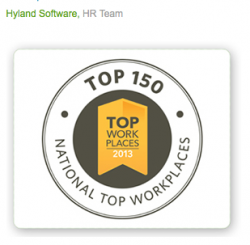 During a trip to a suburban mall near Cleveland, I saw a man wearing a jacket with a logo for Hyland Software, a business-to-business software developer whose global headquarters are located nearby. In the B2B world, Hyland has a reputation of being a stellar employer with a fun streak. As evidence, it has a giant tube slide in the middle of its headquarters and has earned several top workplace awards in recent years.
During a trip to a suburban mall near Cleveland, I saw a man wearing a jacket with a logo for Hyland Software, a business-to-business software developer whose global headquarters are located nearby. In the B2B world, Hyland has a reputation of being a stellar employer with a fun streak. As evidence, it has a giant tube slide in the middle of its headquarters and has earned several top workplace awards in recent years.
Hyland also has a quirk in its interview process. Candidates applying online are required to write and submit a poem. Not an essay, not a biography — a poem. How does that strike you?
I’m guessing some percent of people reading this column are thinking that’s ridiculous. And I know from reading message boards about hiring at Hyland that several past candidates frown upon the poem (that’s putting it nicely). I’m sure at least one applicant has written to the company, “Roses are red, violets are blue. This assignment is stupid, and so are you.”
Many recruiters and HR managers would freak out if they got wind that their interview process was causing a negative reaction. Their job is to put fannies in the seats, and angry candidates don’t help achieve the company’s hiring goals.
I don’t sweat when I hear candidates complain about my company’s pre-employment process. I think repelling some applicants is okay, unless your process turns off candidates who fit your culture. If certain people don’t like your process, that’s probably a good indication they wouldn’t like your job either.
My company is a B2B magazine and website publisher who regularly hires account executives, managers, and writers. Our culture embraces and rewards people who are high character, high initiative, hard working, and humble. We seek to attract folks who value constructive criticism and teamwork and are seeking a long-term career, not just their next job.
So, our interview process is thorough and intense with questions that go beyond skills and personality, seeking to fully understand the candidate’s character. We spend 14-16 hours with successful candidates. Our pre-employment steps include an essay, dinner with their significant other, and an aversions interview where we give the candidate an accurate picture of the struggles they will face on the job.
Partway through our process some candidates bail and tell us we are overwhelming and invasive. But others compliment us for our rigorous system, saying it helped them learn more about themselves and our company before making a major life decision. The general reaction by these candidates is, “At first, I didn’t understand why you’d need to spend so much time with me because every other interview process is much shorter. But now I see that you really value people and take hiring seriously.”
My company’s corporate tagline is “We’re Different By Design,” and I think you’d agree our interview process mirrors that. We would be misleading candidates — and experience high turnover — if we behaved otherwise.
Because that process works for us, does that mean you should copy exactly what my company does? Absolutely not.
These seven actions will ensure your hiring process is effective and in harmony with your culture:
- Review a copy of your organization’s guiding principles and see if they are evident on your recruiting website and within your interview process.
- Compare your website with websites of companies in your industry and companies with cultures similar to yours.
- Call the HR directors and recruiters from those companies to get details on their interview process.
- Review sites of “best-places-to-work” companies for ideas on how they communicate their culture and conduct their pre-employment process. At Jameson, we researched companies on the Forbes list “Companies That Give The Toughest Job Interviews.”
- Ask your recently hired employees if they felt your interview processes accurately depicted your company culture. Note where they feel differences exist.
- Get feedback from “ones that got away” — candidates you wanted to hire but decided to go somewhere else. LinkedIn is a great resource for quickly finding what these folks are up to.
- Ask current candidates in your process how they would describe your company from what they’ve been exposed to. Does it match the perspective you want them to have?
Happy hiring!